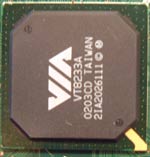
|
When Epox announced the release of the KT333-based 8K3A+ many wondered if they would be able to reproduce the successes they had enjoyed in the past.
82% Rating: 
|
|
|
|
Home >
Reviews >
Motherboards >
Epox EP-8K3A+ |
|
|
Room for improvement?

I've never been as picky about mainboards as when IDE
connectors are placed in spots where cables may have to drape around
precious videocards. For some reason this really irks me and in the case
of the Epox 8K3A+ the placement of the IDE RAID ports on the
motherboard interfere with the use of full
length PCI cards in PCI slots 2-4. Even longer PCI cards such as the Sound
Blaster Audigy would have problems fitting in the last two PCI's on the bottom
of the motherboard.
The ATX power connector is in a 'poor' location since the power cable is
in a position to drape over the CPU fan disturbing air flow if the system is put
together sloppily. However, we also know that the board was designed this way to ensure the
cleanest electricity gets to the power plant on the motherboard.
USB 2.0 is gaining quite abit of
momentum and it is surprising that the 8K3A+ doesn't include that in its package since many of its
competitors have USB 2.0 as standard equipment. Also we were told by Epox that
the passive northbridge heatsink is only on the test/beta samples of the
motherboard, however that doesn't seem to be the case always.
We
have another 8K3A+ in our labs that we purchased and it came with
the passive grey heatsink on its northbridge as well. This had
seemed to inhibit our overclocking attempts and replacing the northbridge heatsink with an active cooler helped
alleviate this problem. On a side note I found it quite amusing that our
retail 8K3A+ was PCB revision 1.0 and the test sample revision 1.2...
h'mm I wonder what changes Epox made to the layout?
A little on RAID...
IDE RAID 0 is not really considered a
true RAID since there isn't any data redundancy. RAID 0 takes two drives of the
same size/configuration and stripes them, meaning it makes one big drive out of
two equal ones. This improves performance by cutting hard drive latency in half.
Since the data is divided equally and written on two hard drives it also
increases the data bandwidth by two. The reason it's not considered true RAID is
because if one drive fails, all data is lost.
IDE RAID 1 on the other hand mirrors two
drives of the same size, so in theory if one drive fails, the other will take
over as the primary hard drive and the system can continue to operate normally.
This is what is supposed to happen with a SCSI hard drive setup and it actually
works pretty well there.
The IDE subsystem doesn't allow hard
drives to be disconnected while the computer is still powered up and in use like
SCSI can unless you have a special HDD tray. Generally, when one IDE drive fails
the system usually locks up anyway. The data is safe since it's mirrored on the
other drive which is the real benefit.
With IDE RAID 0+1, you need four
hard drives of the same configuration/size. What RAID 0+1 does is
stripes two sets of two hard drives, one set for a RAID 0 configuration and the
other for RAID 1. What this does is offer the best of both worlds, the high
performance of RAID 0, with 100% data redundancy of RAID 1. Hence the name RAID
0+1. The only downside would be the need for four identical hard drives.
|
